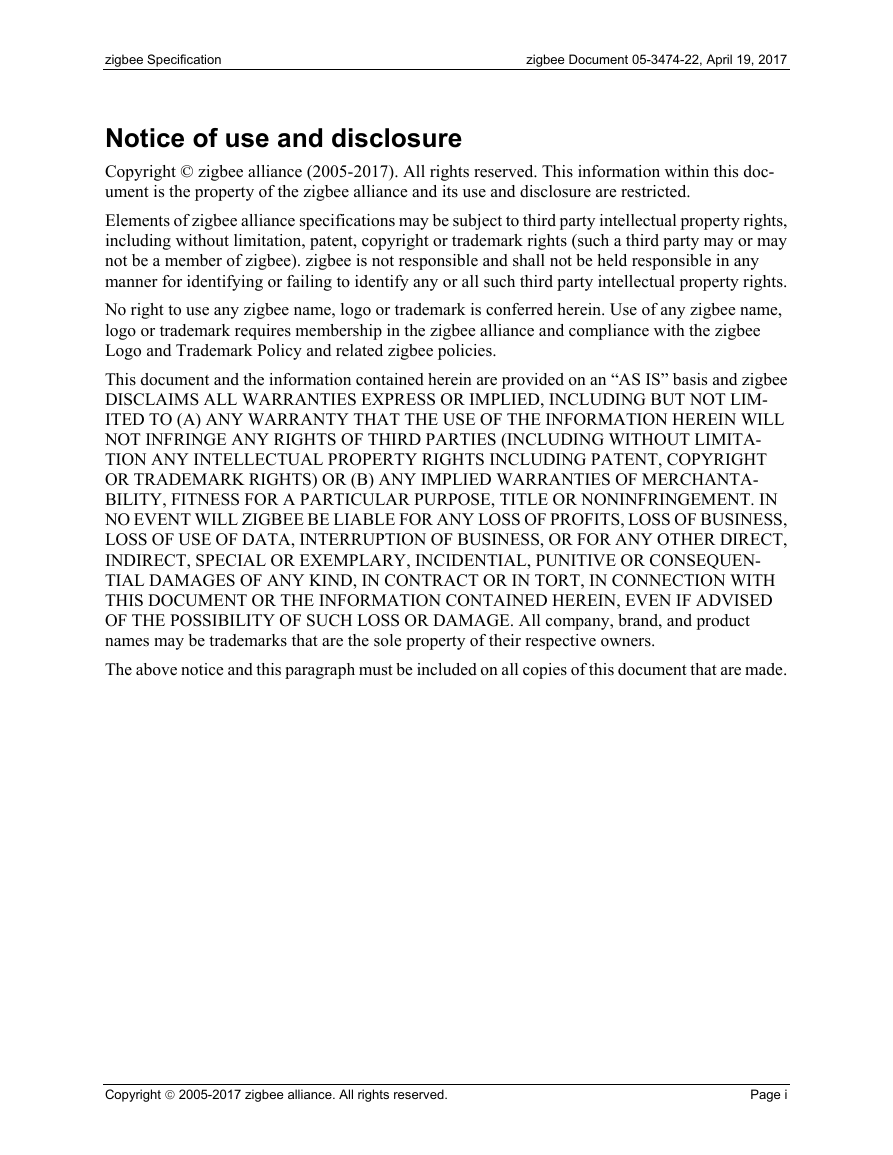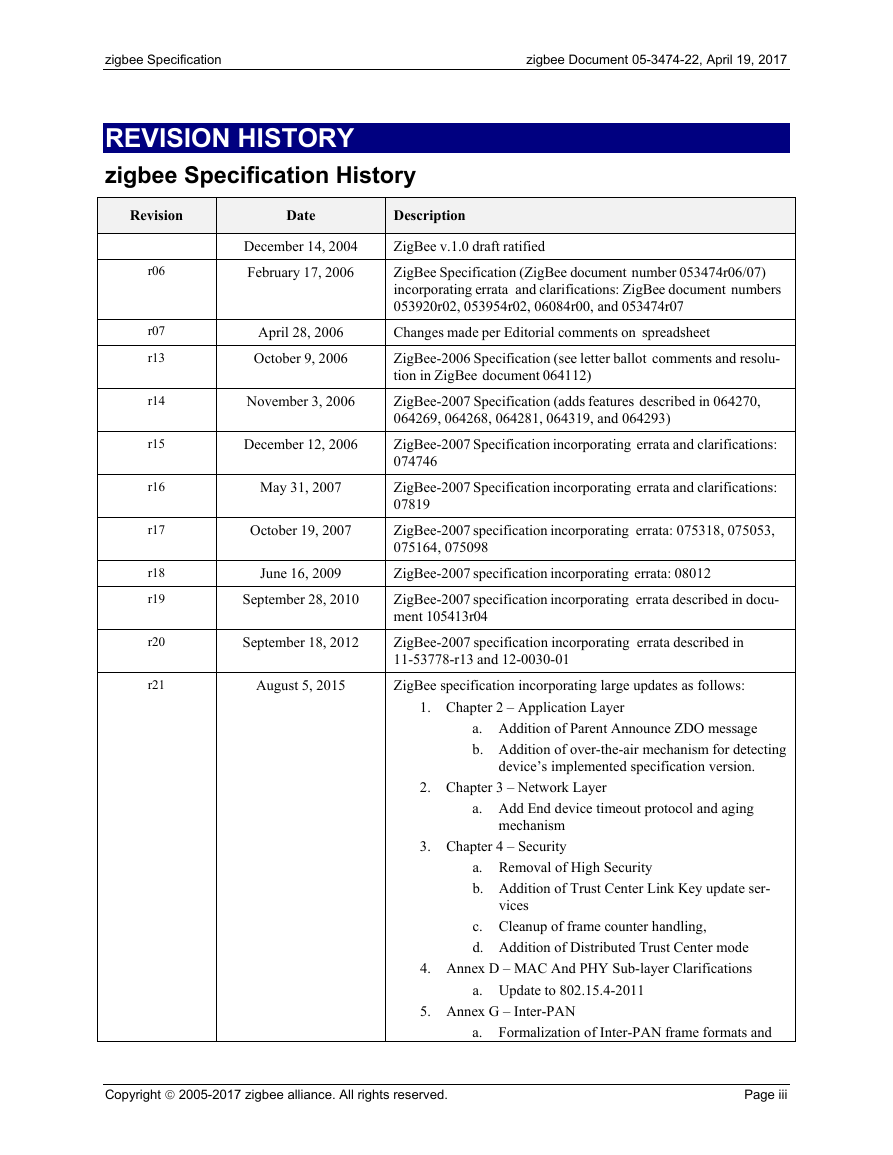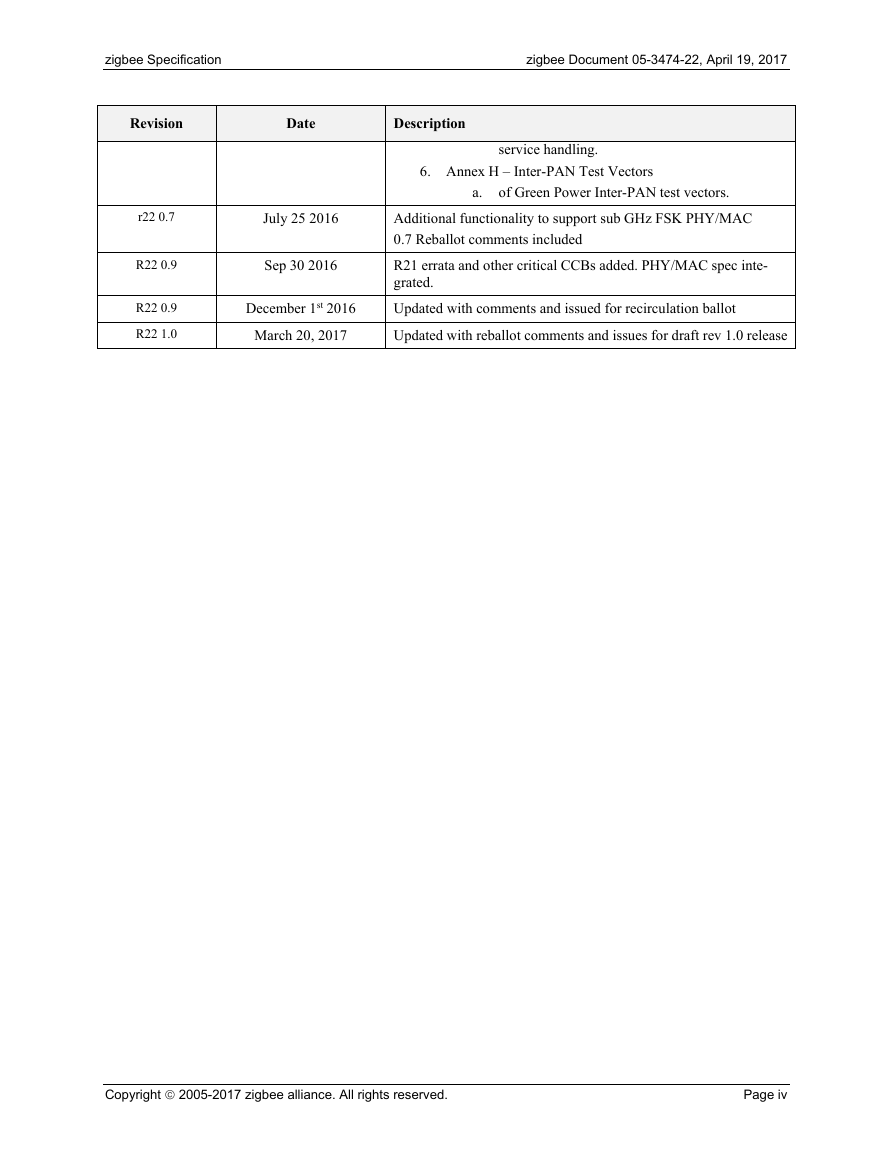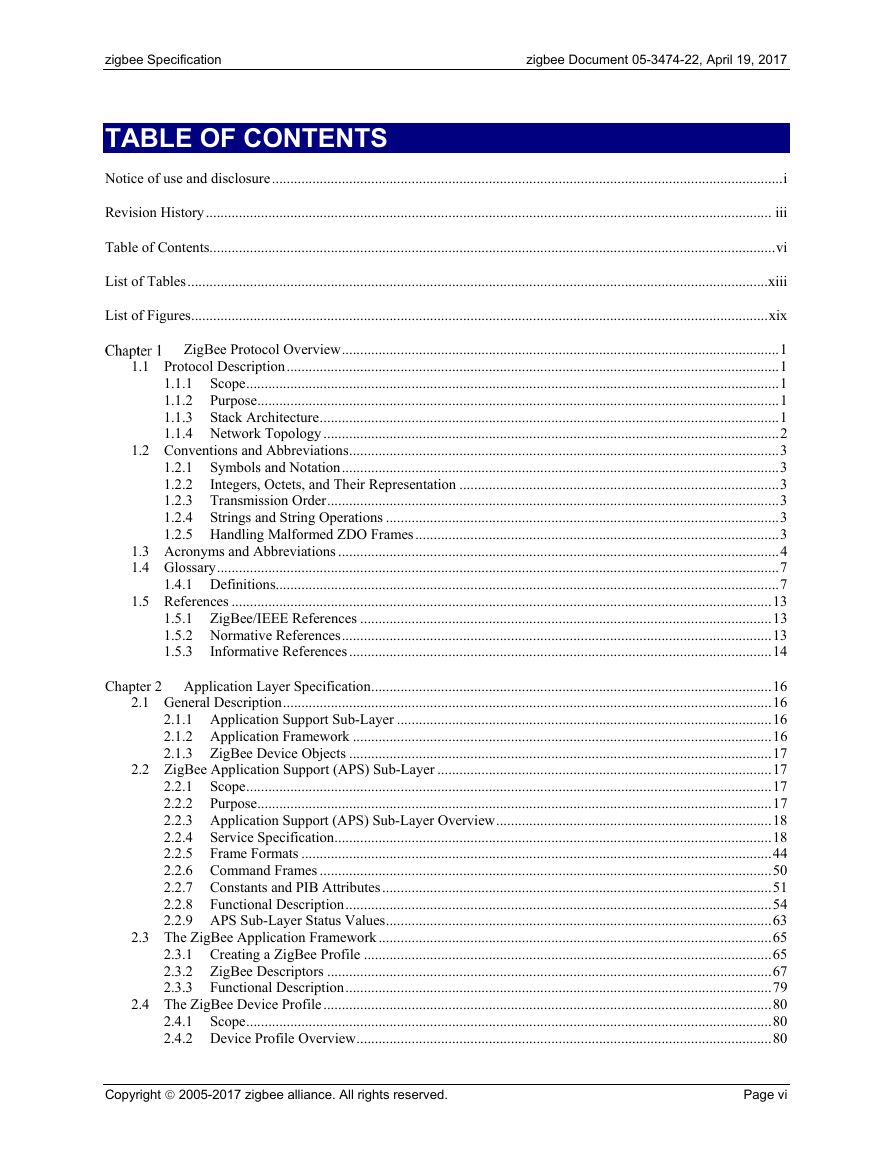Notice of use and disclosure
Revision History
Table of Contents
List of Tables
List of Figures
Chapter 1 ZigBee Protocol Overview
1.1 Protocol Description
1.1.1 Scope
1.1.2 Purpose
1.1.3 Stack Architecture
1.1.3.1 Non-Certifiable Features
1.1.4 Network Topology
1.2 Conventions and Abbreviations
1.2.1 Symbols and Notation
1.2.2 Integers, Octets, and Their Representation
1.2.3 Transmission Order
1.2.4 Strings and String Operations
1.2.5 0F Handling Malformed ZDO Frames
1.3 Acronyms and Abbreviations
1.4 Glossary
1.4.1 Definitions
1.4.1.1 Conformance Levels
1.4.1.2 ZigBee Definitions
1.5 References
1.5.1 ZigBee/IEEE References
1.5.2 Normative References
1.5.3 Informative References
Chapter 2 Application Layer Specification
2.1 General Description
2.1.1 Application Support Sub-Layer
2.1.2 Application Framework
2.1.2.1 Application Profiles
2.1.2.2 Clusters
2.1.3 ZigBee Device Objects
2.1.3.1 Device Discovery
2.1.3.2 Service Discovery
2.2 ZigBee Application Support (APS) Sub-Layer
2.2.1 Scope
2.2.2 Purpose
2.2.3 Application Support (APS) Sub-Layer Overview
2.2.3.1 Application Support Sub-Layer Data Entity (APSDE)
2.2.3.2 Application Support Sub-Layer Management Entity (APSME)
2.2.4 Service Specification
2.2.4.1 APS Data Service
2.2.4.1.1 APSDE-DATA.request
Semantics of the Service Primitive
When Generated
Effect on Receipt
2.2.4.1.2 APSDE-DATA.confirm
Semantics of the Service Primitive
When Generated
Effect on Receipt
2.2.4.1.3 APSDE-DATA.indication
Semantics of the Service Primitive
When Generated
Effect on Receipt
2.2.4.2 APS Management Service
2.2.4.3 Binding Primitives
2.2.4.3.1 APSME-BIND.request
Semantics of the Service Primitive
When Generated
Effect on Receipt
2.2.4.3.2 APSME-BIND.confirm
Semantics of the Service Primitive
When Generated
Effect on Receipt
2.2.4.3.3 APSME-UNBIND.request
Semantics of the Service Primitive
When Generated
Effect on Receipt
2.2.4.3.4 APSME-UNBIND.confirm
Semantics of the Service Primitive
When Generated
Effect on Receipt
2.2.4.4 Information Base Maintenance
2.2.4.4.1 APSME-GET.request
Semantics of the Service Primitive
When Generated
Effect on Receipt
2.2.4.4.2 APSME-GET.confirm
Semantics of the Service Primitive
When Generated
Effect on Receipt
2.2.4.4.3 APSME-SET.request
Semantics of the Service Primitive
When Generated
Effect on Receipt
2.2.4.4.4 APSME-SET.confirm
Semantics of the Service Primitive
When Generated
Effect on Receipt
2.2.4.5 Group Management
2.2.4.5.1 APSME-ADD-GROUP.request
Semantics of the Service Primitive
When Generated
Effect on Receipt
2.2.4.5.2 APSME-ADD-GROUP.confirm
Semantics of the Service Primitive
When Generated
Effect on Receipt
2.2.4.5.3 APSME-REMOVE-GROUP.request
Semantics of the Service Primitive
When Generated
Effect on Receipt
2.2.4.5.4 APSME-REMOVE-GROUP.confirm
Semantics of the Service Primitive
When Generated
Effect on Receipt
2.2.4.5.5 APSME-REMOVE-ALL-GROUPS.request
Semantics of the Service Primitive
When Generated
Effect on Receipt
2.2.4.5.6 APSME-REMOVE-ALL-GROUPS.confirm
Semantics of the Service Primitive
When Generated
Effect on Receipt
2.2.5 Frame Formats
2.2.5.1 General APDU Frame Format
2.2.5.1.1 Frame Control Field
Frame Type Sub-Field
Delivery Mode Sub-Field
Ack Format Field
Security Sub-Field
Acknowledgement Request Sub-Field
Extended Header Present
2.2.5.1.2 Destination Endpoint Field
2.2.5.1.3 Group Address Field
2.2.5.1.4 Cluster Identifier Field
2.2.5.1.5 Profile Identifier Field
2.2.5.1.6 Source Endpoint Field
2.2.5.1.7 APS Counter
2.2.5.1.8 Extended Header Sub-Frame
Extended Frame Control Field
Block Number
Ack Bitfield
2.2.5.1.9 Frame Payload Field
2.2.5.2 Format of Individual Frame Types
2.2.5.2.1 Data Frame Format
Data Payload Field
2.2.5.2.2 APS Command Frame Format
APS Command Frame APS Header Fields
APS Command Identifier Field
APS Command Payload Field
2.2.5.2.3 Acknowledgement Frame Format
Acknowledgement Frame APS Header Fields
2.2.6 Command Frames
2.2.7 Constants and PIB Attributes
2.2.7.1 APS Constants
2.2.7.2 APS Information Base
2.2.8 Functional Description
2.2.8.1 Persistent Data
2.2.8.2 Binding
2.2.8.2.1 Binding Table Implementation
2.2.8.2.2 Binding
2.2.8.3 Group Addressing
2.2.8.3.1 The Group Table
2.2.8.4 Transmission, Reception, and Acknowledgement
2.2.8.4.1 Transmission
2.2.8.4.2 Reception and Rejection
2.2.8.4.3 Use of Acknowledgements
No Acknowledgement
Acknowledgement
2.2.8.4.4 Retransmissions
2.2.8.4.5 Fragmented Transmissions
Transmission
Reception and Rejection, and Acknowledgements
2.2.9 APS Sub-Layer Status Values
2.3 The ZigBee Application Framework
2.3.1 Creating a ZigBee Profile
2.3.1.1 Getting a Profile Identifier from the ZigBee Alliance
2.3.1.2 Defining Device Descriptions and Clusters
2.3.1.3 Deploying the Profile on Endpoints
2.3.1.4 Enabling Service Discovery
2.3.1.5 Mixing Standard and Proprietary Profiles
2.3.1.6 Enabling Backward Compatibility
2.3.2 ZigBee Descriptors
2.3.2.1 Transmission of Descriptors
2.3.2.1.1 Field Count Field
Compressed XML Tag Field
Field Data Field
2.3.2.2 Discovery via Descriptors
2.3.2.3 Node Descriptor
2.3.2.3.1 Logical Type Field
2.3.2.3.2 Complex Descriptor Available Field
2.3.2.3.3 User Descriptor Available Field
2.3.2.3.4 APS Flags Field
2.3.2.3.5 Frequency Band Field
2.3.2.3.6 MAC Capability Flags Field
2.3.2.3.7 Manufacturer Code Field
2.3.2.3.8 Maximum Buffer Size Field
2.3.2.3.9 Maximum Incoming Transfer Size Field
2.3.2.3.10 Server Mask Field
Stack Compliance Revision
2.3.2.3.11 Maximum Outgoing Transfer Size Field
2.3.2.3.12 Descriptor Capability Field
2.3.2.4 Node Power Descriptor
2.3.2.4.1 Current Power Mode Field
2.3.2.4.2 Available Power Sources Field
2.3.2.4.3 Current Power Source Field
2.3.2.4.4 Current Power Source Level Field
2.3.2.5 Simple Descriptor
2.3.2.5.1 Endpoint Field
2.3.2.5.2 Application Profile Identifier Field
2.3.2.5.3 Application Device Identifier Field
2.3.2.5.4 Application Device Version Field
2.3.2.5.5 Application Input Cluster Count Field
2.3.2.5.6 Application Input Cluster List
2.3.2.5.7 Application Output Cluster Count Field
2.3.2.5.8 Application Output Cluster List
2.3.2.6 Complex Descriptor
2.3.2.6.1 Language and Character Set Field
2.3.2.6.2 Manufacturer Name Field
2.3.2.6.3 Model Name Field
2.3.2.6.4 Serial Number Field
2.3.2.6.5 Device URL Field
2.3.2.6.6 Icon Field
2.3.2.6.7 Icon URL Field
2.3.2.7 User Descriptor
2.3.3 Functional Description
2.3.3.1 Reception and Rejection
2.3.3.2 ZDO Messages
2.3.3.3 Application endpoints using Manufacturer Specific Profiles
2.4 The ZigBee Device Profile
2.4.1 Scope
2.4.2 Device Profile Overview
2.4.2.1 Device and Service Discovery Overview
2.4.2.2 End Device Bind Overview
2.4.2.3 Bind and Unbind Overview
2.4.2.4 Binding Table Management Overview
2.4.2.5 Network Management Overview
2.4.2.6 Device Descriptions for the Device Profile
2.4.2.7 Configuration and Roles
2.4.2.8 Transmission of ZDP Commands
2.4.2.8.1 Transaction Sequence Number Field
2.4.2.8.2 Transaction Data Field
2.4.3 Client Services
2.4.3.1 Device and Service Discovery Client Services
2.4.3.1.1 NWK_addr_req
When Generated
Effect on Receipt
2.4.3.1.2 IEEE_addr_req
When Generated
Effect on Receipt
2.4.3.1.3 Node_Desc_req
When Generated
Effect on Receipt
2.4.3.1.4 Power_Desc_req
When Generated
Effect on Receipt
2.4.3.1.5 Simple_Desc_req
When Generated
Effect on Receipt
2.4.3.1.6 Active_EP_req
When Generated
Effect on Receipt
2.4.3.1.7 Match_Desc_req
When Generated
Effect on Receipt
2.4.3.1.8 Complex_Desc_req
When Generated
Effect on Receipt
2.4.3.1.9 User_Desc_req
When Generated
Effect on Receipt
2.4.3.1.10 Discovery_Cache_req – DEPRECATED COMMAND
When Generated
Effect on Receipt
2.4.3.1.11 Device_annce
When Generated
Effect on Receipt
2.4.3.1.12 Parent_annce
When Generated
Effect on receipt
2.4.3.1.13 User_Desc_set
When Generated
Effect on Receipt
2.4.3.1.14 System_Server_Discovery_req
When Generated
Effect on Receipt
2.4.3.1.15 Discovery_store_req
When Generated
Effect on Receipt
2.4.3.1.16 Node_Desc_store_req
When Generated
Effect on Receipt
2.4.3.1.17 Power_Desc_store_req
When Generated
Effect on Receipt
2.4.3.1.18 Active_EP_store_req
When Generated
Effect on Receipt
2.4.3.1.19 Simple_Desc_store_req
When Generated
Effect on Receipt
2.4.3.1.20 Remove_node_cache_req
When Generated
Effect on Receipt
2.4.3.1.21 Find_node_cache_req
When Generated
Effect on Receipt
2.4.3.1.22 Extended_Simple_Desc_req
When Generated
Effect on Receipt
2.4.3.1.23 Extended_Active_EP_req
When Generated
Effect on Receipt
2.4.3.2 End Device Bind, Bind, Unbind, and Bind Management Client Services Primitives
2.4.3.2.1 End_Device_Bind_req
When Generated
Effect on Receipt
2.4.3.2.2 Bind_req
When Generated
Effect on Receipt
2.4.3.2.3 Unbind_req
When Generated
Effect on Receipt
2.4.3.2.4 Bind_Register_req
When Generated
Effect on Receipt
2.4.3.2.5 Replace_Device_req
When Generated
Effect on Receipt
2.4.3.2.6 Store_Bkup_Bind_Entry_req
When Generated
Effect on Receipt
2.4.3.2.7 Remove_Bkup_Bind_Entry_req
When Generated
Effect on Receipt
2.4.3.2.8 Backup_Bind_Table_req
When Generated
Effect on Receipt
2.4.3.2.9 Recover_Bind_Table_req
When Generated
Effect on Receipt
2.4.3.2.10 Backup_Source_Bind_req
When Generated
Effect on Receipt
2.4.3.2.11 Recover_Source_Bind_req
When Generated
Effect on Receipt
2.4.3.3 Network Management Client Services
2.4.3.3.1 Mgmt_NWK_Disc_req – DEPRECATED COMMAND
2.4.3.3.2 Mgmt_Lqi_req
When Generated
Effect on Receipt
2.4.3.3.3 Mgmt_Rtg_req
When Generated
Effect on Receipt
2.4.3.3.4 Mgmt_Bind_req
When Generated
Effect on Receipt
2.4.3.3.5 Mgmt_Leave_req
When Generated
Effect on Receipt
2.4.3.3.6 Mgmt_Direct_Join_req
When Generated
Effect on Receipt
2.4.3.3.7 Mgmt_Permit_Joining_req
When Generated
Effect on Receipt
2.4.3.3.8 Mgmt_Cache_req
When Generated
Effect on Receipt
2.4.3.3.9 Mgmt_NWK_Update_req 13F
When Generated
Effect on Receipt
2.4.3.3.9.1.1 Error Response Procedure
2.4.3.3.10 Mgmt_NWK_Enhanced_Update_req 15F
When Generated
Effect on Receipt
2.4.3.3.11 Mgmt_NWK_IEEE_Joining_List_req
When Generated
Effect on Receipt
2.4.4 Server Services
2.4.4.1 ZDO Response Requirements
2.4.4.2 Device and Service Discovery Server
2.4.4.2.1 NWK_addr_rsp
When Generated
Effect on Receipt
2.4.4.2.2 IEEE_addr_rsp
When Generated
Effect on Receipt
2.4.4.2.3 Node_Desc_rsp
When Generated
Effect on Receipt
2.4.4.2.4 Power_Desc_rsp
When Generated
Effect on Receipt
2.4.4.2.5 Simple_Desc_rsp
When Generated
Effect on Receipt
2.4.4.2.6 Active_EP_rsp
When Generated
Effect on Receipt
2.4.4.2.7 Match_Desc_rsp
When Generated
2.4.4.2.7.1.1 Simple Descriptor Matching Rules
Effect on Receipt
2.4.4.2.8 Complex_Desc_rsp
When Generated
Effect on Receipt
2.4.4.2.9 User_Desc_rsp
When Generated
Effect on Receipt
2.4.4.2.10 System_Server_Discovery_rsp
When Generated
Effect on Receipt
2.4.4.2.11 User_Desc_conf
When Generated
Effect on Receipt
2.4.4.2.12 Discovery_Cache_rsp – DEPRECATED COMMAND
When Generated
Effect on Receipt
2.4.4.2.13 Discovery_store_rsp
When Generated
Effect on Receipt
2.4.4.2.14 Node_Desc_store_rsp
When Generated
Effect on Receipt
2.4.4.2.15 Power_Desc_store_rsp
When Generated
Effect on Receipt
2.4.4.2.16 Active_EP_store_rsp
When Generated
Effect on Receipt
2.4.4.2.17 Simple_Desc_store_rsp
When Generated
Effect on Receipt
2.4.4.2.18 Remove_node_cache_rsp
When Generated
Effect on Receipt
2.4.4.2.19 Find_node_cache_rsp
When Generated
Effect on Receipt
2.4.4.2.20 Extended_Simple_Desc_rsp
When Generated
Effect on Receipt
2.4.4.2.21 Extended_Active_EP_rsp
When Generated
Effect on Receipt
2.4.4.2.22 Parent_annce_rsp
When Generated
Effect on Receipt
2.4.4.3 End Device Bind, Bind, Unbind Bind Management Server Services
2.4.4.3.1 End_Device_Bind_rsp
When Generated
Effect on Receipt
2.4.4.3.2 Bind_rsp
When Generated
Effect on Receipt
2.4.4.3.3 Unbind_rsp
When Generated
Effect on Receipt
2.4.4.3.4 Bind_Register_rsp
When Generated
Effect on Receipt
2.4.4.3.5 Replace_Device_rsp
When Generated
Effect on Receipt
2.4.4.3.6 Store_Bkup_Bind_Entry_rsp
When Generated
Effect on Receipt
2.4.4.3.7 Remove_Bkup_Bind_Entry_rsp
When Generated
Effect on Receipt
2.4.4.3.8 Backup_Bind_Table_rsp
When Generated
Effect on Receipt
2.4.4.3.9 Recover_Bind_Table_rsp
When Generated
Effect on Receipt
2.4.4.3.10 Backup_Source_Bind_rsp
When Generated
Effect on Receipt
2.4.4.3.11 Recover_Source_Bind_rsp
When Generated
Effect on Receipt
2.4.4.4 Network Management Server Services
2.4.4.4.1 Mgmt_NWK_Disc_rsp – DEPRECATED COMMAND
When Generated
Effect on Receipt
2.4.4.4.2 Mgmt_Lqi_rsp
When Generated
Effect on Receipt
2.4.4.4.3 Mgmt_Rtg_rsp
When Generated
Effect on Receipt
2.4.4.4.4 Mgmt_Bind_rsp
When Generated
Effect on Receipt
2.4.4.4.5 Mgmt_Leave_rsp
When Generated
Effect on Receipt
2.4.4.4.6 Mgmt_Direct_Join_rsp
When Generated
Effect on Receipt
2.4.4.4.7 Mgmt_Permit_Joining_rsp
When Generated
Effect on Receipt
2.4.4.4.8 Mgmt_Cache_rsp
When Generated
Effect on Receipt
2.4.4.4.9 Mgmt_NWK_Update_notify
When Generated
Effect on Receipt
2.4.4.4.10 Mgmt_NWK_Enhanced_Update_notify
When Generated
Effect on Receipt
2.4.4.4.11 Mgmt_NWK_IEEE_Joining_List_rsp
When Generated
Effect on receipt
2.4.4.4.12 Mgmt_NWK_Unsolicited_Enhanced_Update_notify
When Generated
Effect on Receipt
2.4.5 ZDP Enumeration Description
2.4.6 Conformance
2.5 The ZigBee Device Objects (ZDO)
2.5.1 Scope
2.5.2 Device Object Descriptions
2.5.2.1 Primary Discovery Cache Device Operation
2.5.2.2 Device and Service Discovery
2.5.2.3 Security Manager
2.5.2.4 Network Manager
2.5.2.5 Binding Manager
2.5.2.6 Node Manager
2.5.2.7 Group Manager
2.5.3 Layer Interface Description
2.5.4 System Usage
2.5.4.1 Object Overview
2.5.4.2 Optional and Mandatory Objects and Attributes
2.5.4.3 Security Key Usage
2.5.4.4 Public and Private Methods
2.5.4.5 State Machine Functional Descriptions
2.5.4.5.1 ZigBee Coordinator
Initialization
Normal Operating State
Trust Center Operation
2.5.4.5.2 ZigBee Router
Initialization
Normal Operating State
2.5.4.5.3 Binding Table Cache Operation
2.5.4.5.4 Operations to Support Intra-PAN Portability
Overview
Description of Operations for Security Verification
Description of Operations for Informing the Rest of the Network
2.5.4.5.5 ZigBee End Device
Initialization
Normal Operating State
2.5.4.5.6 Support for Commissioning Applications
Configuration Attributes
Startup Procedure
Further Commissioning
2.5.4.6 Device and Service Discovery
2.5.4.6.1 Optional and Mandatory Attributes Within Device and Service Discovery
2.5.4.7 Security Manager
2.5.4.7.1 Optional and Mandatory Attributes Within Security Manager
2.5.4.8 Binding Manager
2.5.4.8.1 Optional and Mandatory Attributes Within Binding Manager
2.5.4.9 Network Manager
2.5.4.9.1 Optional and Mandatory Attributes Within Network Manager
2.5.4.10 Node Manager
2.5.4.11 Group Manager
2.5.5 Configuration Attributes
2.5.5.1 Configuration Attribute Definitions
Chapter 3 Network Specification
3.1 General Description
3.1.1 Network (NWK) Layer Overview
3.1.2 Network Layer Data Entity (NLDE)
3.1.2.1 Network Layer Management Entity (NLME)
3.2 Service Specification
3.2.1 NWK Data Service
3.2.1.1 NLDE-DATA.request
3.2.1.1.1 Semantics of the Service Primitive
3.2.1.1.2 When Generated
3.2.1.1.3 Effect on Receipt
3.2.1.2 NLDE-DATA.confirm
3.2.1.2.1 Semantics of the Service Primitive
3.2.1.2.2 When Generated
3.2.1.2.3 Effect on Receipt
3.2.1.3 NLDE-DATA.indication
3.2.1.3.1 Semantics of the Service Primitive
3.2.1.3.2 When Generated
3.2.1.3.3 Effect on Receipt
3.2.2 NWK Management Service
3.2.2.1 MAC Interfaces
3.2.2.2 Network Management Data Structures
3.2.2.2.1 Channel List Structure
3.2.2.2.2 Validating the List of Channels
3.2.2.2.3 Energy Detect List Structure
3.2.2.3 NLME-NETWORK-DISCOVERY.request
3.2.2.3.1 Semantics of the Service Primitive
3.2.2.3.2 When Generated
3.2.2.3.3 Effect on Receipt
3.2.2.4 NLME-NETWORK-DISCOVERY.confirm
3.2.2.4.1 Semantics of the Service Primitive
3.2.2.4.2 When Generated
3.2.2.4.3 Effect on Receipt
3.2.2.5 NLME-NETWORK-FORMATION.request
3.2.2.5.1 Semantics of the Service Primitive
3.2.2.5.2 When Generated
3.2.2.5.3 Effect on Receipt
3.2.2.6 NLME-NETWORK-FORMATION.confirm
3.2.2.6.1 Semantics of the Service Primitive
3.2.2.6.2 When Generated
3.2.2.6.3 Effect on Receipt
3.2.2.7 NLME-PERMIT-JOINING.request
3.2.2.7.1 Semantics of the Service Primitive
3.2.2.7.2 When Generated
3.2.2.7.3 Effect on Receipt
3.2.2.8 NLME-PERMIT-JOINING.confirm
3.2.2.8.1 Semantics of the Service Primitive
3.2.2.8.2 When Generated
3.2.2.8.3 Effect on Receipt
3.2.2.9 NLME-START-ROUTER.request
3.2.2.9.1 Semantics of the Service Primitive
3.2.2.9.2 When Generated
3.2.2.9.3 Effect on Receipt
3.2.2.10 NLME-START-ROUTER.confirm
3.2.2.10.1 Semantics of the Service Primitive
3.2.2.10.2 When Generated
3.2.2.10.3 Effect on Receipt
3.2.2.11 NLME-ED-SCAN.request
3.2.2.11.1 Semantics of the Service Primitive
3.2.2.11.2 When Generated
3.2.2.11.3 Effect on Receipt
3.2.2.12 NLME-ED-SCAN.confirm
3.2.2.12.1 Semantics of the Service Primitive
3.2.2.12.2 When Generated
3.2.2.12.3 Effect on Receipt
3.2.2.13 NLME-JOIN.request
3.2.2.13.1 Semantics of the Service Primitive
3.2.2.13.2 When Generated
3.2.2.13.3 Effect on Receipt
3.2.2.14 NLME-JOIN.indication
3.2.2.14.1 Semantics of the Service Primitive
3.2.2.14.2 When Generated
3.2.2.14.3 Effect on Receipt
3.2.2.15 NLME-JOIN.confirm
3.2.2.15.1 Semantics of the Service Primitive
3.2.2.15.2 When Generated
3.2.2.15.3 Effect on Receipt
3.2.2.16 NLME-DIRECT-JOIN.request
3.2.2.16.1 Semantics of the Service Primitive
3.2.2.16.2 When Generated
3.2.2.16.3 Effect on Receipt
3.2.2.17 NLME-DIRECT-JOIN.confirm
3.2.2.17.1 Semantics of the Service Primitive
3.2.2.17.2 When Generated
3.2.2.17.3 Effect on Receipt
3.2.2.18 NLME-LEAVE.request
3.2.2.18.1 Semantics of the Service Primitive
3.2.2.18.2 When Generated
3.2.2.18.3 Effect on Receipt
3.2.2.19 NLME-LEAVE.indication
3.2.2.19.1 Semantics of the Service Primitive
3.2.2.19.2 When Generated
3.2.2.19.3 Effect on Receipt
3.2.2.20 NLME-LEAVE.confirm
3.2.2.20.1 Semantics of the Service Primitive
3.2.2.20.2 When Generated
3.2.2.20.3 Effect on Receipt
3.2.2.21 NLME-RESET.request
3.2.2.21.1 Semantics of the Service Primitive
3.2.2.21.2 When Generated
3.2.2.21.3 Effect on Receipt
3.2.2.22 NLME-RESET.confirm
3.2.2.22.1 Semantics of the Service Primitive
3.2.2.22.2 When Generated
3.2.2.22.3 Effect on Receipt
3.2.2.23 Network Layer Reset Message Sequence Chart
3.2.2.24 NLME-SYNC.request
3.2.2.24.1 Semantics of the Service Primitive
3.2.2.24.2 When Generated
3.2.2.24.3 Effect on Receipt
3.2.2.25 NLME-SYNC-LOSS.indication
3.2.2.25.1 Semantics of the Service Primitive
3.2.2.25.2 When Generated
3.2.2.25.3 Effect on Receipt
3.2.2.26 NLME-SYNC.confirm
3.2.2.26.1 Semantics of the Service Primitive
3.2.2.26.2 When Generated
3.2.2.26.3 Effect on Receipt
3.2.2.27 Message Sequence Charts for Synchronization
3.2.2.28 NLME-GET.request
3.2.2.28.1 Semantics of the Service Primitive
3.2.2.28.2 When Generated
3.2.2.28.3 Effect on Receipt
3.2.2.29 NLME-GET.confirm
3.2.2.29.1 Semantics of the Service Primitive
3.2.2.29.2 When Generated
3.2.2.29.3 Effect on Receipt
3.2.2.30 NLME-SET.request
3.2.2.30.1 Semantics of the Service Primitive
3.2.2.30.2 When Generated
3.2.2.30.3 Effect on Receipt
3.2.2.31 NLME-SET.confirm
3.2.2.31.1 Semantics of the Service Primitive
3.2.2.31.2 When Generated
3.2.2.31.3 Effect on Receipt
3.2.2.32 NLME-NWK-STATUS.indication
3.2.2.32.1 Semantics of the Service Primitive
3.2.2.32.2 When Generated
3.2.2.32.3 Effect on Receipt
3.2.2.33 NLME-ROUTE-DISCOVERY.request
3.2.2.33.1 Semantics of the Service Primitive
3.2.2.33.2 When Generated
3.2.2.33.3 Effect on Receipt
3.2.2.34 NLME_ROUTE-DISCOVERY.confirm
3.2.2.34.1 Semantics of the Service Primitive
3.2.2.34.2 When Generated
3.2.2.34.3 Effect on Receipt
3.2.2.35 NLME-SET-INTERFACE.request
3.2.2.35.1 Semantics of the Service Primitive
3.2.2.35.2 When Generated
3.2.2.35.3 Effect on Receipt
3.2.2.36 NLME-SET-INTERFACE.confirm
3.2.2.36.1 Semantics of the Service Primitive
3.2.2.36.2 When Generated
3.2.2.36.3 Effect on Receipt
3.2.2.37 NLME-GET-INTERFACE.request
3.2.2.37.1 Semantics of the Service Primitive
3.2.2.37.2 When Generated
3.2.2.37.3 Effect on Receipt
3.2.2.38 NLME-GET-INTERFACE.confirm
3.2.2.38.1 Semantics of the Service Primitive
3.2.2.38.2 When Generated
3.2.2.38.3 Effect on Receipt
3.2.2.39 NLME-DUTY-CYCLE-MODE.indication
3.2.2.39.1 Semantics of this primitive
3.2.2.39.2 When Generated
3.2.2.39.3 Effect on Receipt
3.3 Frame Formats
3.3.1 General NPDU Frame Format
3.3.1.1 Frame Control Field
3.3.1.1.1 Frame Type Sub-Field
3.3.1.1.2 Protocol Version Sub-Field
3.3.1.1.3 Discover Route Sub-Field
3.3.1.1.4 Multicast Flag Sub-Field
3.3.1.1.5 Security Sub-Field
3.3.1.1.6 Source Route Sub-Field
3.3.1.1.7 Destination IEEE Address Sub-Field
3.3.1.1.8 Source IEEE Address Sub-Field
3.3.1.1.9 End Device Initiator
3.3.1.2 Destination Address Field
3.3.1.3 Source Address Field
3.3.1.4 Radius Field
3.3.1.5 Sequence Number Field
3.3.1.6 Destination IEEE Address Field
3.3.1.7 Source IEEE Address Field
3.3.1.8 Multicast Control Field
3.3.1.8.1 Multicast Mode Sub-Field
3.3.1.8.2 NonmemberRadius Sub-Field
3.3.1.8.3 MaxNonmemberRadius Sub-Field
3.3.1.9 Source Route Subframe Field
3.3.1.9.1 Relay Count Sub-Field
3.3.1.9.2 Relay Index
3.3.1.9.3 Relay List Sub-Field
3.3.1.9.4 Frame Payload Field
3.3.2 Format of Individual Frame Types
3.3.2.1 Data Frame Format
3.3.2.1.1 Data Frame NWK Header Field
3.3.2.1.2 Data Payload Field
3.3.2.2 NWK Command Frame Format
3.3.2.2.1 NWK Command Frame NWK Header Field
3.3.2.2.2 NWK Command Identifier Field
3.3.2.2.3 NWK Command Payload Field
3.4 Command Frames
3.4.1 Route Request Command
3.4.1.1 MAC Data Service Requirements
3.4.1.2 NWK Header Fields
3.4.1.3 NWK Payload Fields
3.4.1.3.1 Command Options Field
Many-to-One
Destination IEEE Address
Multicast Sub-Field
3.4.1.3.2 Route Request Identifier
3.4.1.3.3 Destination Address
3.4.1.3.4 Path Cost
3.4.1.3.5 Destination IEEE Address
3.4.2 Route Reply Command
3.4.2.1 MAC Data Service Requirements
3.4.2.2 NWK Header Fields
3.4.2.3 NWK Payload Fields
3.4.2.3.1 Command Options Field
Originator IEEE Address
Responder IEEE Address
Multicast Sub-Field
3.4.2.3.2 Route Request Identifier
3.4.2.3.3 Originator Address
3.4.2.3.4 Responder Address
3.4.2.3.5 Path Cost
3.4.2.3.6 Originator IEEE Address
3.4.2.3.7 Responder IEEE Address
3.4.3 Network Status Command
3.4.3.1 MAC Data Service Requirements
3.4.3.2 NWK Header Fields
3.4.3.3 NWK Payload Fields
3.4.3.3.1 Status Code
3.4.3.3.2 Destination Address
3.4.4 Leave Command
3.4.4.1 MAC Data Service Requirement
3.4.4.2 NWK Header Fields
3.4.4.3 NWK Payload Fields
3.4.4.3.1 Command Options Field
Rejoin Sub-Field
Request Sub-Field
Remove Children Sub-Field
3.4.5 Route Record Command
3.4.5.1 MAC Data Service Requirements
3.4.5.2 NWK Header Fields
3.4.5.3 NWK Payload
3.4.5.3.1 Relay Count Field
3.4.5.3.2 Relay List Field
3.4.6 Rejoin Request Command
3.4.6.1 MAC Data Service Requirements
3.4.6.2 NWK Header Fields
3.4.6.3 NWK Payload Fields
3.4.6.3.1 Capability Information Field
3.4.7 Rejoin Response Command
3.4.7.1 MAC Data Service Requirements
3.4.7.2 NWK Header Fields
3.4.7.3 NWK Payload Fields
3.4.7.3.1 Network Address Field
3.4.7.3.2 Rejoin Status Field
3.4.8 Link Status Command
3.4.8.1 MAC Data Service Requirements
3.4.8.2 NWK Header Fields
3.4.8.3 NWK Payload Fields
3.4.8.3.1 Command Options Field
3.4.8.3.2 Link Status List Field
3.4.9 Network Report Command
3.4.9.1 MAC Data Service Requirements
3.4.9.2 NWK Header Fields
3.4.9.3 NWK Payload Fields
3.4.9.3.1 Command Options Field
Report Information Count Sub-Field
Report Command Identifier Sub-Field
3.4.9.3.2 EPID Field
3.4.9.3.3 Report Information
PAN Identifier Conflict Report
3.4.10 Network Update Command
3.4.10.1 MAC Data Service Requirements
3.4.10.2 NWK Header Fields
3.4.10.3 NWK Payload Fields
3.4.10.3.1 Command Options Field
Update Information Count Sub-Field
Update Command Identifier Sub-Field
3.4.10.3.2 EPID Field
3.4.10.3.3 Update Id Field
3.4.10.3.4 Update Information
PAN Identifier Update
3.4.11 End Device Timeout Request Command
3.4.11.1 MAC Data Service Requirements
3.4.11.2 NWK Header fields
3.4.11.3 NWK Payload Fields
3.4.11.3.1 Requested Timeout Field
3.4.11.3.2 End Device Configuration Field
3.4.12 End Device Timeout Response Command
3.4.12.1 MAC Data Service Requirements
3.4.12.2 NWK Header fields
3.4.12.2.1 NWK Payload Fields
3.4.13 Link Power Delta Command
3.4.13.1 MAC Data Service Requirements
3.4.13.2 NWK Header Fields
3.4.13.3 NWK Payload Fields
3.4.13.3.1 Command Options Field
3.4.13.3.1.1 List Count
3.4.13.3.1.2 Power List
3.4.13.3.1.2.1 Device Address
3.4.13.3.1.2.2 Delta Power
3.4.13.4 Link Power Delta command behaviour
3.5 Constants and NIB Attributes
3.5.1 NWK Constants
3.5.2 NWK Information Base
3.5.2.1 Broadcast Delivery Time
3.6 Functional Description
3.6.1 Network and Device Maintenance
3.6.1.1 Establishing a New Network
3.6.1.2 Permitting Devices to Join a Network
3.6.1.3 Network Discovery
3.6.1.4 Joining a Network
3.6.1.4.1 Joining a Network Through Association
Child Procedure
Parent Procedure
3.6.1.4.2 Joining or Rejoining a Network Using NWK Rejoin
Child Procedure
Parent Procedure
3.6.1.4.3 Joining a Network Directly
Joining or Re-joining a Network Through Orphaning
Child Procedure
Parent Procedure
3.6.1.5 Neighbor Tables
3.6.1.6 Distributed Address Assignment Mechanism
3.6.1.7 Stochastic Address Assignment Mechanism
3.6.1.8 Installation and Addressing
3.6.1.9 Address Conflicts
3.6.1.9.1 Obtaining Address Information
3.6.1.9.2 Detecting Address Conflicts
3.6.1.9.3 Resolving Address Conflicts
3.6.1.10 Leaving a Network
3.6.1.10.1 Method for a Device to Initiate Its Own Removal from the Network
3.6.1.10.2 Method for a Device to Remove Its Child from the Network
3.6.1.10.3 Upon Receipt of the Leave Command Frame
Validation of the leave request
3.6.1.10.4 Local Process for Leaving the network
3.6.1.11 Changing the ZigBee Coordinator Configuration
3.6.1.12 Resetting a Device
3.6.1.13 Managing a PANId Conflict
3.6.1.13.1 Detecting a PANId Conflict
3.6.1.13.2 Upon Receipt of a Network Report Command Frame
3.6.1.13.3 Upon Receipt of a Network Update Command Frame
3.6.2 Transmission and Reception
3.6.2.1 Transmission
3.6.2.2 Reception and Rejection
3.6.2.3 Examination for End Devices that have changed Router Parents
3.6.3 Routing
3.6.3.1 Routing Cost
3.6.3.2 Routing Tables
3.6.3.3 Upon Receipt of a Unicast Frame
3.6.3.3.1 Originating a Source Routed Data Frame
3.6.3.3.2 Relaying a Source Routed Data Frame
3.6.3.4 Link Status Messages
3.6.3.4.1 Initiation of a Link Status Command Frame
3.6.3.4.2 Upon Receipt of a Link Status Command Frame
3.6.3.4.3 Aging the Neighbor Table
3.6.3.5 Route Discovery
3.6.3.5.1 Initiation of Route Discovery
3.6.3.5.2 Upon Receipt of a Route Request Command Frame
3.6.3.5.3 Upon Receipt of a Route Reply Command Frame
3.6.3.5.4 Initiation and Processing of a Route Record Command Frame
3.6.3.6 Upon Expiration of a Route Discovery Table Entry
3.6.3.7 Route Maintenance
3.6.3.7.1 In Case of Link Failure
3.6.4 Scheduling Beacon Transmissions
3.6.4.1 Scheduling Method
3.6.5 Broadcast Communication
3.6.6 Multicast Communication
3.6.6.1 The Group ID Table
3.6.6.2 Upon Receipt of a Multicast Frame from the Next Higher Layer
3.6.6.2.1 Initiating a Member Mode Multicast
3.6.6.2.2 Initiating a Non-Member Mode Multicast
3.6.6.3 Upon Receipt of a Member Mode Multicast Frame
3.6.6.4 Upon Receipt of a Non-Member Mode Multicast Frame
3.6.7 NWK Information in the MAC Beacons
3.6.8 Persistent Data
3.6.9 Low Power Routers (LPR)
3.6.10 End Device Aging and Management
3.6.10.1 End Device Aging Mechanism
3.6.10.2 Establishing the Timeout
3.6.10.3 End Device Keepalive
3.6.10.4 MAC Data Poll Processing
3.6.10.4.1 Sending a Leave Message
3.6.10.5 Setting the End Device Timeout on the Router Parent
3.6.10.6 Local End Device Timeout
3.6.10.7 Persistent Values on the Parent Router
3.6.10.8 Reboot and Child Aging
3.6.10.9 Diagrams Illustrating End Device Management
3.6.10.10 Trust Center Rejoin or Secure Rejoin
3.6.11 Power Negotiation
3.6.11.1 Behavior
3.6.11.2 Determining support for Power Negotiation
3.6.11.2.1 Generating Link Power Delta messages
3.6.12 Multiple MAC Interfaces
3.6.12.1 Multi-MAC Selection Device
3.6.12.2 Multi-MAC Switch Device
3.6.13 Unknown Commands
3.7 NWK Layer Status Values
Chapter 4 Security Services Specification
4.1 Document Organization
4.2 General Description
4.2.1 Security Architecture and Design
4.2.1.1 Security Assumptions
4.2.1.2 Security Design Choices
4.2.1.2.1 Security Keys
4.2.1.2.2 ZigBee Security Architecture
4.2.2 NWK Layer Security
4.2.3 APL Layer Security
4.2.3.1 Transport Key
4.2.3.2 Update Device
4.2.3.3 Remove Device
4.2.3.4 Request Key
4.2.3.5 Switch Key
4.2.3.6 Verify-Key
4.2.3.7 Confirm Key
4.2.4 Trust Center Role
4.3 NWK Layer Security
4.3.1 Frame Security
4.3.1.1 Security Processing of Outgoing Frames
4.3.1.2 Security Processing of Incoming Frames
4.3.2 Secured NPDU Frame
4.3.3 Security-Related NIB Attributes
4.3.4 Network Frame Counter Requirements
4.3.4.1 Network Frame Counter Usage Calculations
4.4 APS Layer Security
4.4.1 Frame Security
4.4.1.1 Security Processing of Outgoing Frames
4.4.1.2 Security Processing of Incoming Frames
4.4.1.3 Security Processing of APS Commands
4.4.1.4 Conditional Encryption of APS Commands
4.4.1.5 Acceptance of Commands Based on Security Policy
4.4.1.6 Conditional Encryption of APS Data
4.4.2 Transport-Key Services
4.4.2.1 APSME-TRANSPORT-KEY.request
4.4.2.1.1 Semantics of the Service Primitive
4.4.2.1.2 When Generated
4.4.2.1.3 Effect on Receipt
4.4.2.2 APSME-TRANSPORT-KEY.indication
4.4.2.2.1 Semantics of the Service Primitive
4.4.2.2.2 When Generated
4.4.2.2.3 Effect on Receipt
4.4.2.3 Upon Receipt of a Transport-Key Command
4.4.3 Update Device Services
4.4.3.1 APSME-UPDATE-DEVICE.request
4.4.3.1.1 Semantics of the Service Primitive
4.4.3.1.2 When Generated
4.4.3.1.3 Effect on Receipt
4.4.3.2 APSME-UPDATE-DEVICE.indication
4.4.3.2.1 Semantics of the Service Primitive
4.4.3.2.2 When Generated
4.4.3.2.3 Effect on Receipt
4.4.4 Remove Device Services
4.4.4.1 APSME-REMOVE-DEVICE.request
4.4.4.1.1 Semantics of the Service Primitive
4.4.4.1.2 When Generated
4.4.4.1.3 Effect on Receipt
4.4.4.2 APSME-REMOVE-DEVICE.indication
4.4.4.2.1 Semantics of the Service Primitive
4.4.4.2.2 When Generated
4.4.4.2.3 Effect on Receipt
4.4.5 Request Key Services
4.4.5.1 APSME-REQUEST-KEY.request
4.4.5.1.1 Semantics of the Service Primitive
4.4.5.1.2 When Generated
4.4.5.1.3 Effect on Receipt
4.4.5.2 APSME-REQUEST-KEY.indication
4.4.5.2.1 Semantics of the Service Primitive
4.4.5.2.2 When Generated
4.4.5.2.3 Effect on Receipt
4.4.6 Switch Key Services
4.4.6.1 APSME-SWITCH-KEY.request
4.4.6.1.1 Semantics of the Service Primitive
4.4.6.1.2 When Generated
4.4.6.1.3 Effect on Receipt
4.4.6.2 APSME-SWITCH-KEY.indication
4.4.6.2.1 Semantics of the Service Primitive
4.4.6.2.2 When Generated
4.4.6.2.3 Effect on Receipt
4.4.7 Verify-Key Services
4.4.7.1 APSME-VERIFY-KEY.request
4.4.7.1.1 Semantics of the Service Primitive
4.4.7.1.2 When Generated
4.4.7.1.3 Effect on Receipt
4.4.7.2 APSME-VERIFY-KEY.indication
4.4.7.2.1 Semantics of the Service Primitive
4.4.7.2.2 When Generated
4.4.7.2.3 Effect on Receipt
APSME-VERIFY-KEY.indication Response
4.4.8 Confirm-Key Services
4.4.8.1 APSME-CONFIRM-KEY.request
4.4.8.1.1 Semantics of the Service Primitive
4.4.8.1.2 When Generated
4.4.8.1.3 Effect on Receipt
4.4.8.2 APSME-CONFIRM-KEY.indication
4.4.8.2.1 Semantics of the Service Primitive
4.4.8.2.2 When Generated
4.4.8.2.3 Effect on Receipt
4.4.9 Secured APDU Frame
4.4.10 Command Frames
4.4.10.1 Transport-Key Commands
4.4.10.1.1 Command Identifier Field
4.4.10.1.2 StandardKeyType Field
4.4.10.1.3 Key Descriptor Field
Trust Center Link Key Descriptor Field
Network Key Descriptor Field
Application Link Key Descriptor Field
4.4.10.2 Update Device Commands
4.4.10.2.1 Command Identifier Field
4.4.10.2.2 Device Address Field
4.4.10.2.3 Device Short Address Field
4.4.10.2.4 Status Field
4.4.10.3 Remove Device Commands
4.4.10.3.1 Command Identifier Field
4.4.10.3.2 Target Address Field
4.4.10.4 Request-Key Commands
4.4.10.4.1 Command Identifier Field
4.4.10.4.2 RequestKeyType Field
4.4.10.4.3 Partner Address Field
4.4.10.5 Switch-Key Commands
4.4.10.5.1 Command Identifier Field
4.4.10.5.2 Sequence Number Field
4.4.10.6 Tunnel Command
4.4.10.6.1 Command Identifier Field
4.4.10.6.2 Destination Address
4.4.10.6.3 Tunneled Auxiliary Frame Field
4.4.10.6.4 Tunneled Command Field
4.4.10.7 Verify-Key Command
Chapter 2
Chapter 3
Chapter 4
4.1
4.2
4.3
4.4
4.4.1
4.4.2
4.4.3
4.4.4
4.4.5
4.4.6
4.4.7
4.4.8
4.4.9
4.4.10
4.4.10.1
4.4.10.2
4.4.10.3
4.4.10.4
4.4.10.5
4.4.10.6
4.4.10.7
4.4.10.7.1 Command Identifier Field
4.4.10.7.2 StandardKeyType Field
4.4.10.7.3 Source Address
4.4.10.7.4 Initiator Verify-Key Hash Value
4.4.10.8 Confirm-Key Command
4.4.10.8.1 Command Identifier Field
4.4.10.8.2 Status
4.4.10.8.3 StandardKeyType
4.4.10.8.4 Destination Address
4.4.11 Security-Related AIB Attributes
4.5 Common Security Elements
4.5.1 Auxiliary Frame Header Format
4.5.1.1 Security Control Field
4.5.1.1.1 Security Level Sub-Field
4.5.1.1.2 Key Identifier Sub-Field
4.5.1.1.3 Extended Nonce Sub-Field
4.5.1.2 Counter Field
4.5.1.3 Source Address Field
4.5.1.4 Key Sequence Number Field
4.5.2 Security Parameters
4.5.2.1 CCM Mode of Operation and Parameters
4.5.2.2 CCM Nonce
4.5.3 Cryptographic Key Hierarchy
4.5.4 Implementation Requirements
4.5.4.1 Random Number Generator
4.6 Functional Description
4.6.1 ZigBee Security Initialization
4.6.2 Trust Center Application
4.6.2.1 Distributed Security Mode
4.6.2.2 Centralized Security Mode
4.6.3 Security Procedures
4.6.3.1 Joining a Secured Network
4.6.3.2 Authorization
4.6.3.2.1 Router Operation
4.6.3.2.2 Trust Center Operation
Initial Key Distribution
4.6.3.2.3 Joining Device Operation
Preconfigured Trust Center Link Key
4.6.3.2.4 Message Sequence Charts
4.6.3.3 Rejoining Security
4.6.3.3.1 Secure Rejoin
4.6.3.3.2 Trust Center Rejoin
4.6.3.3.3 Coordinator and Router Operation
4.6.3.3.4 Rejoining Device Operation
4.6.3.4 Network Key Update
4.6.3.4.1 Trust Center Operation
4.6.3.4.2 Network Device Operation
4.6.3.4.3 Message Sequence Chart
4.6.3.5 End-to-End Application Key Establishment
4.6.3.5.1 Device Operation
Upon Receipt of a Link Key
4.6.3.5.2 Trust Center Operation
4.6.3.5.3 Message Sequence Chart
4.6.3.6 Network Leave
4.6.3.6.1 Trust Center Operation
4.6.3.6.2 Router Operation
4.6.3.6.3 Leaving Device Operation
4.6.3.6.4 Message Sequence Charts
4.6.3.7 Command Tunneling
4.6.3.7.1 Trust Center Operation
4.6.3.7.2 Parent Operations
4.6.3.7.3 Tunneled Data Destination Operation
4.7 Security Operations in Centralized Security Networks
4.7.1 Trust Center Policies
4.7.2 Trust Center Link Keys
4.7.3 Trust Center Policy Values
4.7.3.1 Allowing Devices to Join
4.7.3.2 Remote Device Changing Trust Center Policy
4.7.3.3 Determining the Link Key for Encryption or Decryption by the Trust Center
4.7.3.4 Rejecting the Join or Rejoin
4.7.3.5 Removing Devices
4.7.3.6 Processing Trust Center Link Key Requests
4.7.3.6.1 Procedure for Generating and Sending a new Trust Center Link Key
4.7.3.7 Alternate methods of Updating the Trust Center Link Key
4.7.3.8 Processing Application Link Key Requests
4.7.3.8.1 Procedure for Generating and Sending Application Link Keys
4.7.3.9 Key Lifetime
4.7.3.9.1 Link Key Lifetime
4.7.3.9.2 Network Key Lifetime
4.7.3.10 Updating the Network Key
4.7.3.10.1 Period of Updates
4.7.3.10.2 Sleepy Devices
4.7.3.10.3 Broadcast Network Key Updates
4.7.3.10.4 Unicast Network Key Updates
4.7.3.10.5 Key Switch
4.7.3.10.6 Old Network Keys
4.8 Security Operations in Distributed Security Networks
4.8.1 Trust Center Address
4.8.2 Network Key Updates
4.8.3 Link Keys
4.8.4 Application Link Keys
4.8.5 Requesting Keys
4.9 Device Operations
4.9.1 Joining Device Policy Values
4.9.2 Trust Center Address
4.9.3 Trust Center Link Keys
4.9.4 Receiving new Link Keys
4.9.5 Requesting a Link Key
Annex A CCM* Mode of Operation
A.1 Notation and Representation
A.2 CCM* Mode Encryption and Authentication Transformation
A.2.1 Input Transformation
A.2.2 Authentication Transformation
A.2.3 Encryption Transformation
A.3 CCM* Mode Decryption and Authentication Checking Transformation
A.3.1 Decryption Transformation
A.3.2 Authentication Checking Transformation
A.4 Restrictions
Annex B Security Building Blocks
B.1 Symmetric-Key Cryptographic Building Blocks
B.1.1 Block-Cipher
B.1.2 Mode of Operation
B.1.3 Cryptographic Hash Function
B.1.4 Keyed Hash Function for Message Authentication
B.1.5 Specialized Keyed Hash Function for Message Authentication
B.1.6 Challenge Domain Parameters
B.2 Key Agreement Schemes
B.2.1 Symmetric-Key Key Agreement Scheme
B.3 Challenge Domain Parameter Generation and Validation
B.3.1 Challenge Domain Parameter Generation
B.3.2 Challenge Domain Parameter Verification
B.4 Challenge Validation Primitive
B.5 Secret Key Generation (SKG) Primitive
B.6 Block-Cipher-Based Cryptographic Hash Function
B.7 Symmetric-Key Authenticated Key Agreement Scheme
B.7.1 Initiator Transformation
B.7.2 Responder Transformation
B.8 Mutual Symmetric-Key Entity Authentication
B.8.1 Initiator Transformation
B.8.2 Responder Transformation
Annex C Test Vectors for Cryptographic Building Blocks
C.1 Data Conversions
C.2 AES Block Cipher
C.3 CCM* Mode Encryption and Authentication Transformation
C.3.1 Input Transformation
C.3.2 Authentication Transformation
C.3.3 Encryption Transformation
C.4 CCM* Mode Decryption and Authentication Checking Transformation
C.4.1 Decryption Transformation
C.4.2 Authentication Checking Transformation
C.5 Cryptographic Hash Function
C.5.1 Test Vector Set 1
C.5.2 Test Vector Set 2
C.5.3 Test Vector Set 3
C.5.4 Test Vector 4
C.5.5 Test Vector 5
C.5.6 Test Vector 6
C.6 Keyed Hash Function for Message Authentication
C.6.1 Test Vector Set 1
C.6.2 Test Vector Set 2
C.6.3 Specialized Keyed Hash Function for Message Authentication
Annex D MAC and PHY Sub-Layer Clarifications
D.1 Introduction
D.1.1 Scope
D.1.2 Purpose
D.2 Stack Size Issues
D.3 MAC Association
D.4 aMaxMACFrameSize
D.5 Frame Version Value
D.6 CSMA Backoff Timing
D.7 Recommended Scan Duration
D.8 MAC Interface Changes
D.8.1 Additional Primitives accessed through the MLME-SAP
D.8.2 MLME-POLL.indication
D.8.2.1 Semantics of the service primitive
D.8.2.2 When Generated
D.8.2.3 Effect on Receipt
D.9 Optional MAC Feature Enhancements
D.9.1 Enhanced Beacon Request and Enhanced Beacon (response)
D.9.1.1 Enhanced Beacon Filter IE (used for joining)
D.9.1.2 Additional Filtering When Joining
D.9.1.3 Rejoining a Network
D.9.1.4 ZigBee Payload IE
D.9.1.5 Support for non-enhanced beaconing
D.9.1.6 Association Following an Enhanced Beacon
D.9.2 MAC Support for Power Control
D.9.2.1 Power Control Primitive Parameters
D.9.2.1.1 Rssi Parameter
D.9.2.2 TX Power IE for EBR and EB (During Joining and Rejoining Process)
D.9.2.3 Power Control Information Table
D.9.2.3.1 MLME-GET-POWER-INFORMATION-TABLE.request
D.9.2.3.1.1 Semantics of the Service Primitive
D.9.2.3.2 MLME-GET-POWER-INFORMATION-TABLE.confirm
D.9.2.3.2.1 Semantics of the Service Primitive
D.9.2.3.3 MLME-SET-POWER-INFORMATION-TABLE.request
D.9.2.3.3.1 Semantics of the Service Primitive
D.9.2.3.4 MLME-SET-POWER-INFORMATION-TABLE.confirm
D.9.2.3.4.1 Semantics of the Service Primitive
D.9.2.4 Power Control Functional Description
D.9.2.4.1 Power Control during Energy Scans and Active Scans
D.9.2.4.2 Power Control during EBR and EB Frames
D.9.2.4.3 Ongoing Power Control
D.9.2.4.4 Power Control Tx Power Limits
D.9.2.4.5 Tx Power for Devices not in Power Control Information Table
D.10 European Sub-GHz FSK PHY Specification
D.10.1 European Sub-GHz FSK Frame Format
D.10.1.1 PPDU Format for European Sub-GHz FSK
D.10.1.1.1 SHR for European Sub-GHz FSK
D.10.1.1.2 PHR for European Sub-GHz FSK
D.10.1.1.3 PSDU Format for European Sub-GHz FSK
D.10.2 European Sub-GHz FSK PHY
D.10.2.1 Modulation Specification
D.10.2.1.1 Forward Error Correction (FEC)
D.10.2.1.2 Data Whitening
D.10.2.1.3 Channels and Frequencies
D.10.2.1.3.1 Channel Numbering
D.10.2.1.3.2 Channel Pages
D.10.2.2 European Sub-GHz FSK RF Requirements
D.10.2.2.1 Receiver Requirements
D.10.2.2.1.1 Standard Measurement Conditions
D.10.2.2.1.2 Sensitivity Requirement
D.10.2.2.1.3 Co-channel Rejection Requirement
D.10.2.2.1.4 Selectivity Requirements
D.10.2.2.1.5 Blocking Requirements
D.10.2.2.2 Receive Power Level (Rssi)
D.10.2.2.3 Transmitter Requirements
D.10.2.2.3.1 Maximum Transmit Power
D.10.2.2.3.2 Minimum Transmit Power
D.10.2.2.3.3 Transmit Power Step Size and Accuracy
D.10.3 Channel Plan and Masks
D.11 European Sub-GHz FSK MAC Specification
D.11.1 MAC Support for Duty Cycle Monitoring
D.11.1.1 Duty Cycle Monitoring Specific MAC Constants and PIB Attributes
D.11.1.2 Duty Cycle calculations over measurement period
D.11.1.2.1 Accumulating the Duty Cycle Used
D.11.1.2.1.1 Examples of Selecting Values for aDUTYCYCLEBuckets
D.11.1.3 DC_CheckMode()
D.11.1.4 DC_Bump Buckets
D.11.1.5 Accumulate Transmit Time
D.11.1.6 Duty Cycle Monitoring Primitives Accessed Through the MLME-SAP
D.11.1.6.1 MLME-DUTY-CYCLE-MODE.indication
D.11.1.6.2 Semantics of the Service Primitive
D.11.1.6.3 When Generated
D.11.1.6.4 Duty Cycle Operating Modes
D.11.2 MAC Support for Listen Before Talk (LBT)
D.11.2.1 LBT Specific MAC Constants and PIB Attributes - Implementation
D.11.2.2 LBT Compliance when Changing Between Transmit/Receive Mode
D.11.2.3 LBT and ACK Timing
D.11.2.4 LBT Routines
D.11.2.4.1 LBT_Tick()
D.11.2.4.2 LBT_TickReset()
D.11.2.4.3 LBT_TickIncrement()
D.11.2.4.4 LBT_TickExhaust()
D.11.2.4.5 LBT_Backoff()
D.11.2.4.6 LBT_ACK()
D.11.2.4.7 LBT_LBT()
D.11.2.4.8 LBT_TX() (to be included as part of regular TX operation)
D.11.2.4.9 LBT_RX()
D.11.2.4.10 LBT_RadioRx()
D.11.2.4.11 LBT_RadioTx()
D.11.2.4.12 LBT_ RadioReady()
D.11.2.4.13 LBT_ RadioOff()
D.11.2.5 Consequence of LBT on devices
D.11.2.6 Notes on LBT
Annex E Operating Network Manager as Network Channel Manager for Interference Reporting and Resolution
Annex F Usage of Multiple Frequency Bands
F.1 Introduction
F.1.1 Scope
F.1.2 Purpose
F.2 Channels and Channel Masks Management General Guideline
F.2.1 Channel Selection During Network Establishment
F.2.2 The Frequency Agility Feature Related Points
F.2.3 Network Management Services and Client Services Affected by Multiple Frequency Bands Support
F.3 Timing Issues
Annex G Inter-PAN Communications
G.1 Scope and Purpose
G.2 General Description
G.2.1 What Inter-PAN APS Does
G.2.2 Service Specification
G.2.3 The INTRP-DATA.request Primitive
G.2.3.1 Semantics of the Service Primitive
G.2.3.2 When Generated
G.2.3.3 Effect on Receipt
G.2.4 The INTRP-DATA.indication Primitive
G.2.4.1 Semantics of the Service Primitive
G.2.4.2 When Generated
G.2.4.3 Effect on Receipt
G.2.5 Qualifying and Testing of Inter-PAN Messages
G.3 Frame Formats
G.3.1 MAC Header
G.3.1.1 MAC Header usage for Inter-PAN messaging
G.3.2 Network Header
G.3.2.1 Stub NWK Header for Inter-PAN Messages
G.3.2.1.1 Remaining Fields of the Stub NWK Header for GPDF
G.3.3 Inter-PAN APS Header
G.4 Frame Processing
G.4.1 Inter-PAN Transmission (non Green Power Device Frames)
G.4.2 Inter-PAN Reception (non Green Power Device Frames)
G.5 Inter-PAN Best Practices
Annex H Security Test Vectors For Green Power Device Frames
















 2023年江西萍乡中考道德与法治真题及答案.doc
2023年江西萍乡中考道德与法治真题及答案.doc 2012年重庆南川中考生物真题及答案.doc
2012年重庆南川中考生物真题及答案.doc 2013年江西师范大学地理学综合及文艺理论基础考研真题.doc
2013年江西师范大学地理学综合及文艺理论基础考研真题.doc 2020年四川甘孜小升初语文真题及答案I卷.doc
2020年四川甘孜小升初语文真题及答案I卷.doc 2020年注册岩土工程师专业基础考试真题及答案.doc
2020年注册岩土工程师专业基础考试真题及答案.doc 2023-2024学年福建省厦门市九年级上学期数学月考试题及答案.doc
2023-2024学年福建省厦门市九年级上学期数学月考试题及答案.doc 2021-2022学年辽宁省沈阳市大东区九年级上学期语文期末试题及答案.doc
2021-2022学年辽宁省沈阳市大东区九年级上学期语文期末试题及答案.doc 2022-2023学年北京东城区初三第一学期物理期末试卷及答案.doc
2022-2023学年北京东城区初三第一学期物理期末试卷及答案.doc 2018上半年江西教师资格初中地理学科知识与教学能力真题及答案.doc
2018上半年江西教师资格初中地理学科知识与教学能力真题及答案.doc 2012年河北国家公务员申论考试真题及答案-省级.doc
2012年河北国家公务员申论考试真题及答案-省级.doc 2020-2021学年江苏省扬州市江都区邵樊片九年级上学期数学第一次质量检测试题及答案.doc
2020-2021学年江苏省扬州市江都区邵樊片九年级上学期数学第一次质量检测试题及答案.doc 2022下半年黑龙江教师资格证中学综合素质真题及答案.doc
2022下半年黑龙江教师资格证中学综合素质真题及答案.doc